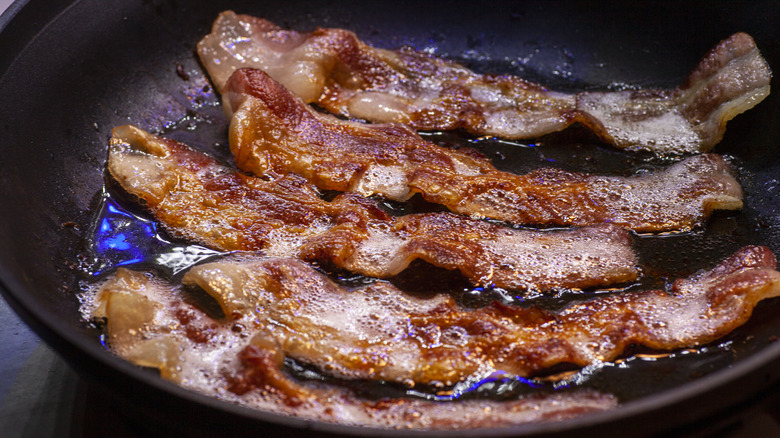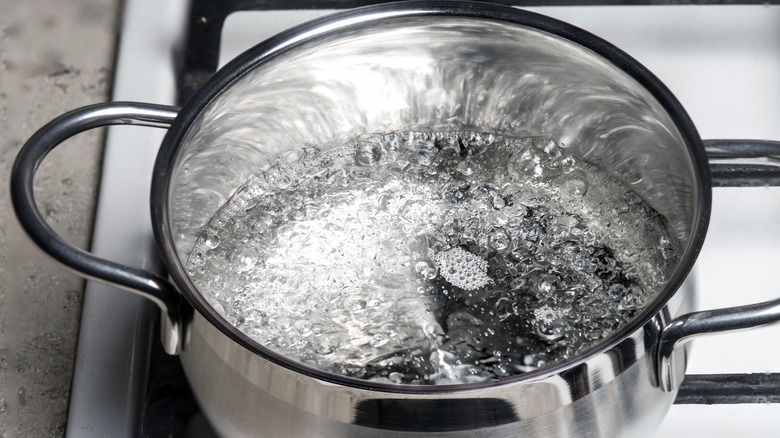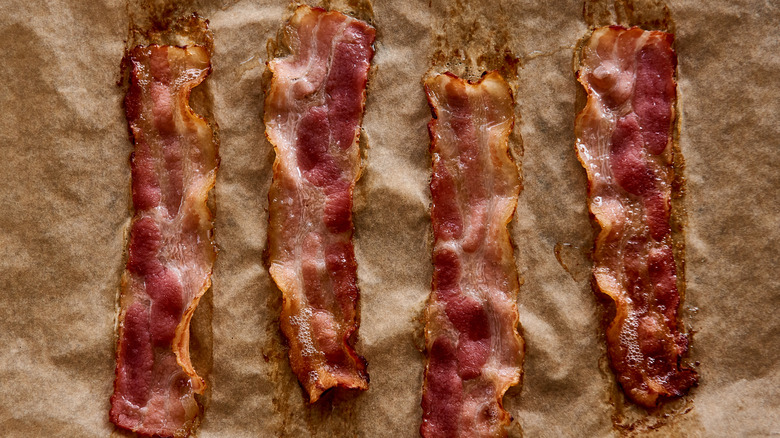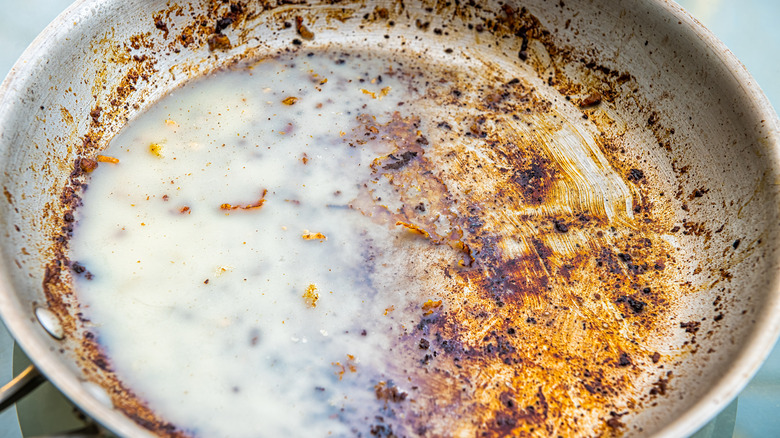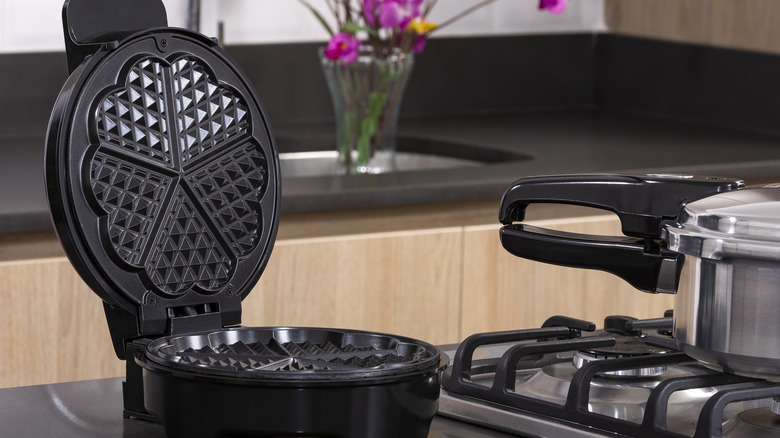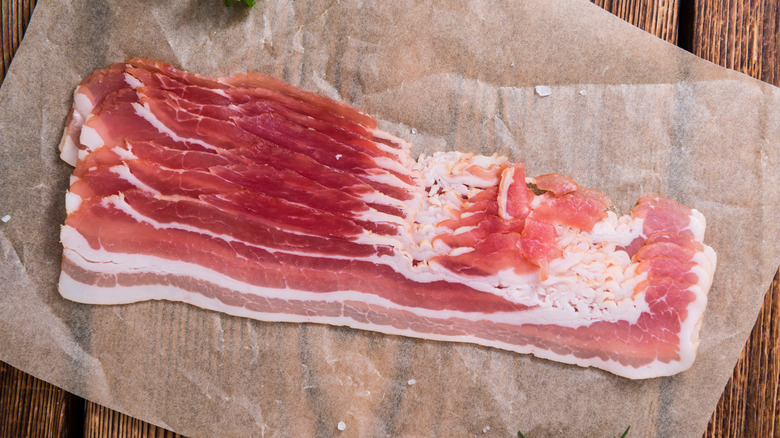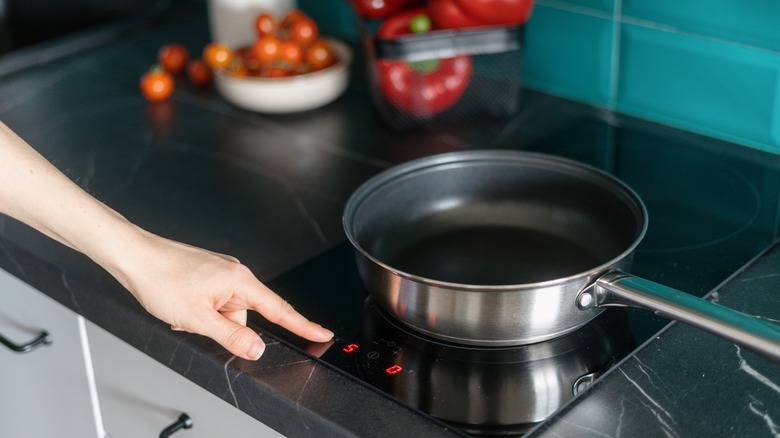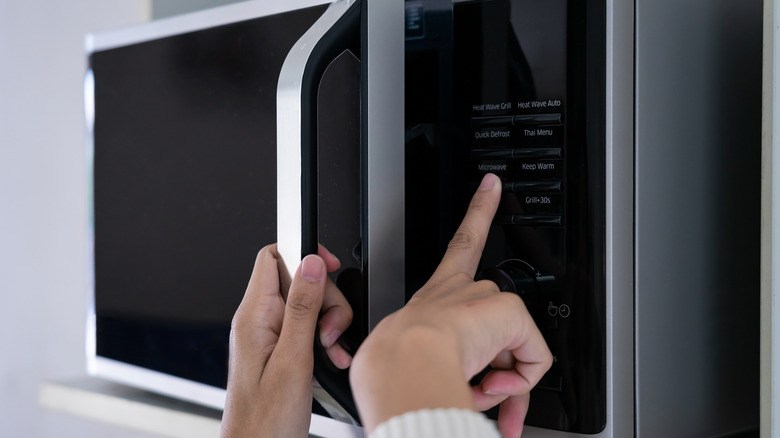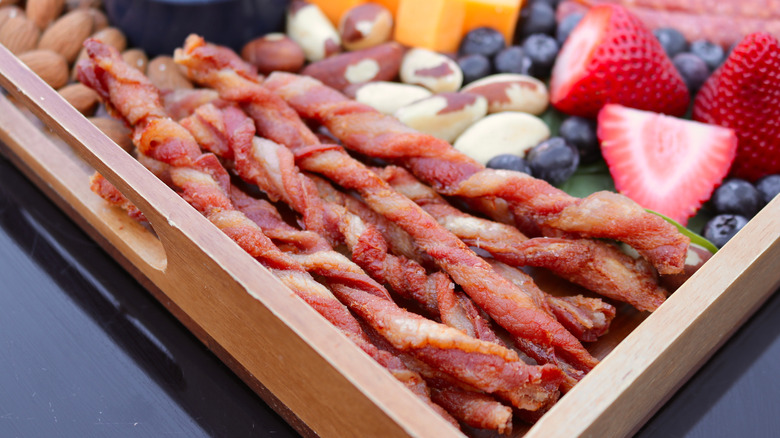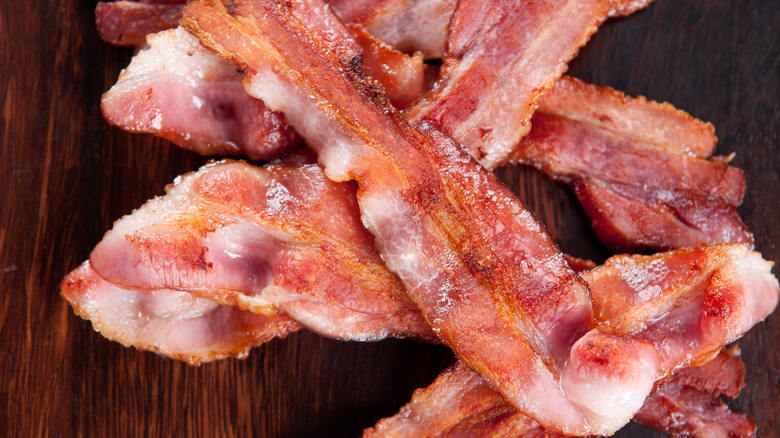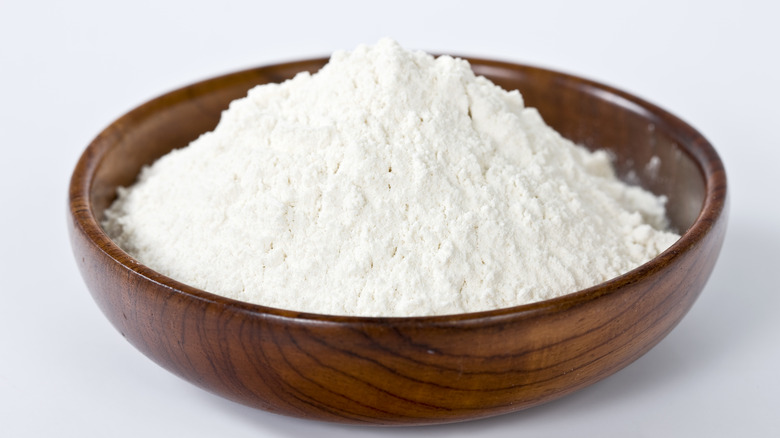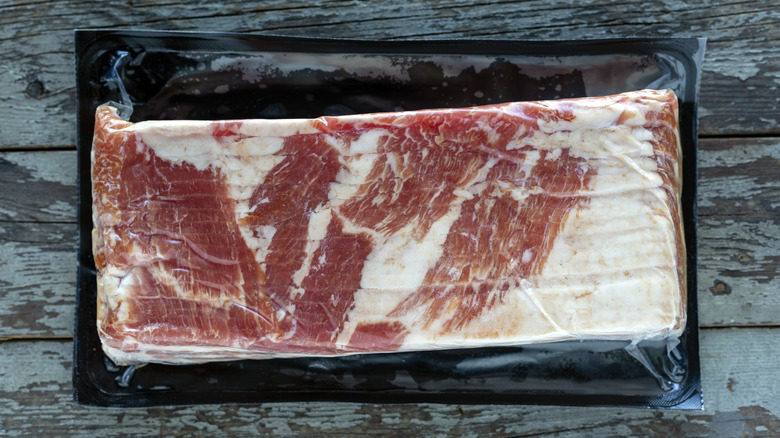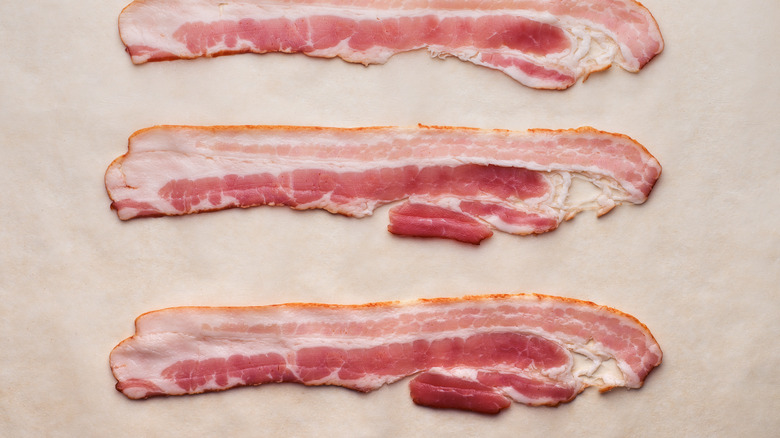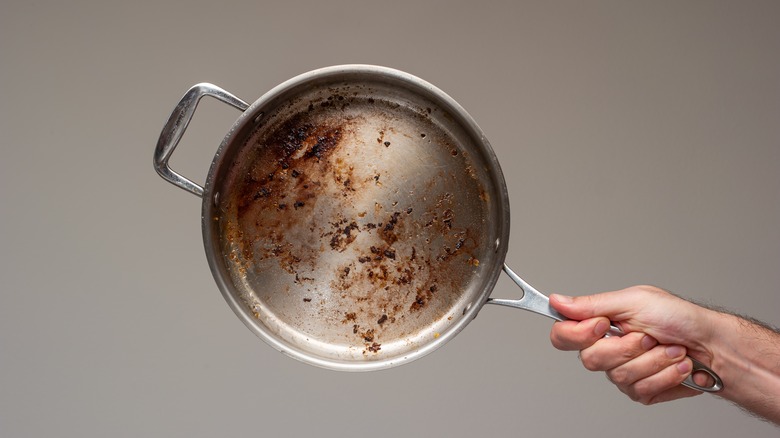13 Hacks That All Bacon Lovers Need To Know
Most people can agree that bacon is irresistible. It's smokey, tender, sweet, and crispy, and it undoubtedly enhances whatever meal that's been blessed with its presence. Adding it onto your burger or with your breakfast at a restaurant is a no-brainer, but making it yourself at home is a different story.
Let's be real – preparing bacon in your own kitchen can, unfortunately, be a messy process. Between the greasy pan and the inevitably bacon-y scent that sticks around longer than it should is not fun to deal with. The awkward packaging that bacon comes in also makes storing leftovers a whole ordeal. And, arguably the most frustrating issue, is getting your bacon to come out perfect every time, which isn't as easy as it sounds. Achieving that perfect crispy exterior without burning your strips is a skill that most bacon lovers could only dream of having. But the good news is that with a few simple hacks, you can craft the best bacon of your life, all at home and without the mess.
Boil your bacon for an even crisp
The perfect strip of bacon is crispy all over without any of those chewy bits. If you've made bacon at home before, you know that this ideal is hard to obtain. This is due to the fact that the fat of the bacon takes longer to cook than the meat. So to prevent burning half of the bacon, you've likely removed the bacon from the heat before the fatty part of the bacon could fully render out, leaving you with bacon that has some rubbery spots.
The solution? Boiling your bacon. While this might sound counterintuitive, the trick is to add some water to your pan while frying your bacon – just enough to cover your strips entirely. This keeps the pan's heat at a more moderate temperature, which allows the fat to cook fully without the meat getting overcooked. You don't need to drain the water, either, it will simply evaporate from the heat and leave you with evenly cooked and crispy bacon every time.
Cook bacon in the oven for less mess
Cooking bacon in the oven is a great set-it-and-forget-it method that has only one downside: You'll be eating a lot more bacon after trying it once. All you need to do is line a sheet pan with parchment paper and your bacon strips after preheating the oven to 400 degrees F. Let the bacon cook until it reaches your ideal level of crispiness. And that's really it.
There's a lot to love about cooking your bacon in the oven. Cleaning up is easy since you can simply throw away that greasy parchment paper, leaving you with a clean sheet pan that's ready to go back into the cabinet. And surprisingly, baking your bacon is a fool-proof way to achieve a perfectly even crisp. That means no chewy fatty sections in your strips. The best part, though, is that you can cook a whole bunch of bacon at once, instead of limiting yourself to the small size of a frying pan. So if you're cooking up breakfast for the whole family, using an oven to cook your bacon is the way to go.
Save the bacon drippings for later
Incorporating bacon drippings into your cooking is an ingenious way to infuse all that bacon-y goodness into everyday meals. By swapping standard oils with bacon grease, it'll make your food taste much richer and more flavorful. Consider it your secret weapon in the kitchen. And when it comes to cooking with bacon grease, the possibilities are endless. You can use it when making burgers, frying hash browns, whipping up an omelet, and prepping a soup base. It can even be used as a drizzle when roasting vegetables in the oven for a burst of unexpected flavor.
To collect all that lovely bacon grease, cooking your bacon low and slow is key. Over very low heat, plan to cook your bacon for about 10 to 12 minutes before straining the fat through a fine mesh strainer. It's best to skip the plastic and store the bacon grease in a glass tupperware or jar to prevent a plastic flavor from making its way into your drippings.
Use a waffle iron to cook your bacon
If you're a bacon lover with a waffle iron, then it's your lucky day. Waffle irons are undoubtedly an underrated tool to use when cooking bacon. For one, it's way easier to use than a pan and a lot cleaner. Just heat the iron up, place the strips on and close the iron for a few minutes – no babysitting required. The end result is cooked bacon and no oil splatters on your cabinet doors. And thanks to all the nooks and crannies in waffle irons, the bacon will form crispy edges that you can't get by simply laying them flat to cook.
These small alcoves also do an excellent job of capturing the delicious bacon grease that can be utilized for another purpose (think waffles cooked in bacon grease). Most waffle irons come with detachable plates that are dishwasher-safe to make cleanup extra easy, which is completely necessary once in a bacon-induced food coma.
Let your bacon sit before cooking
An important tip when it comes to cooking bacon is to let it come up to room temperature before cooking it. As much as you may want to throw your bacon in a hot pan right away after taking it out of the fridge, that can actually prevent your bacon from cooking properly. This happens because the fatty part of the bacon stays colder for longer compared to the meaty part. So when you go to cook your cold bacon, there's a really good chance you'll create a bacon with rubbery bits along the strips.
This obviously isn't ideal, since you want bacon strips that are consistently crispy. The secret is to let the fat and meat in your bacon reach the same temperature before throwing it on the pan, so aim to let your bacon sit for at least 15 minutes before cooking it. While this will take a little planning ahead and lots of patience, the results will be worth it.
Use a cold pan when frying bacon
When frying pretty much anything, the standard operating procedure is to let the pan and oil heat up first before adding in any ingredients. Preheating your skillet is almost always recommended since it will prevent food from sticking to the pan and also creates a nice crust on whatever you're cooking. But when it comes to frying up some strips of bacon, you'll actually want to do the opposite. Yes, this goes against everything you've been taught about frying food, but hear us out.
By using a cold pan when cooking with bacon, you'll allow the fatty and meaty parts of the bacon to heat up together at the same temperature. If your pan starts off too hot, your bacon will cook too quickly, which definitely isn't ideal. This will lead to bacon that's only crispy in some areas and rubbery in others. So for a consistent crisp, make sure you start off cooking your bacon in a cold pan only.
To microwave bacon, drape bacon over a bowl
Using a microwave to cook your bacon is one of the most convenient methods out there. There's virtually no mess to deal with (oil splatters who?), the bacon stretch after cooking is minimal, and it only takes a few minutes to get ready-to-eat bacon on the table.
There is, of course, a major downside to using the microwave instead of another cooking method, which is chewy bacon. It's a tough pill to swallow, but don't write off microwaving your bacon just yet. There's actually a hack to get the most out of microwaving your bacon so you're left with crispy strips instead of rubbery ones. The trick is to use a microwavable bowl, turning it upside down, draping the bacon strips on top, and placing the bowl on top of an even larger plate. The bottom of the bowl will allow the bacon grease to easily slide out from the bacon while the plate acts as a reservoir for all the drippings. By keeping the bacon separate from its grease, your bacon will crisp up more successfully and you'll end up with the crispiest microwaved bacon you could ever hope to achieve.
Twist your strips for extra crispy, chewy bacon
Of all the crispy bacon hacks, the technique of twisting your bacon reigns supreme. By twisting your bacon before cooking it, it creates all these new edges in your bacon that crisp up perfectly, resulting in the crunchiest bacon you've probably ever had. And the more you twist your bacon, the crunchier it gets, so you can customize this method to achieve your ideal level of crispiness.
A trick to get the most twist out of your bacon is to twirl it raw around a wood skewer. Then it's recommended to bake it in the oven for a more even cook – ideally on a rack to allow the bacon grease to drip away. Keep in mind that twisting your bacon will require a longer cooking time than if you cooked your bacon flat. It's suggested to cook the bacon at 400 degrees F for 30 minutes total, though you can experiment with the temperature and time in the oven so it's cooked to your liking.
For less fat, opt for center-cut bacon
It's no secret that bacon isn't the best for you. One reason for this is that bacon is high in saturated fat, which can increase your total cholesterol levels and create blockages in your arteries, according to Harvard Health. In general, bacon should really only be enjoyed on occasion. But there is also another way to make sure your bacon intake is a bit less harmful to your overall health. Turkey bacon is undoubtedly the best option, but if you prefer pork, the key is to opt for a center cut.
There are several cuts of bacon out there, including side bacon (aka streaky bacon), regular bacon and center cut bacon. Side bacon is the fattiest cut available, so if you're looking for a healthy-ish option, try to avoid this one. Regular bacon is similar to center-cut bacon in that they both have more meat than side bacon, but regular bacon still has a bit more fat compared to center-cut. Essentially, center-cut bacon is regular bacon with the fatty edges removed. According to Hormel, it has about 25% less fat than your standard bacon, which ultimately makes it the best choice for the health-conscious bacon lover.
Add flour to bacon before baking or frying
There is one surprising ingredient that will give you textbook bacon every time, and it's likely sitting in your pantry right now. All-purpose flour is actually one of the best things to use to take your bacon up a notch, and it's really easy to use. Simply sprinkle some flour on top of your bacon strips before throwing it in the oven at 400 F.
And don't worry about overloading your bacon with flour. The more flour, the better. You can even dredge it if you'd like. The magic lies in the flour's impeccable ability to absorb excess bacon grease, which gives your bacon a restaurant-quality crisp. And not only that, but it helps the bacon stay pretty flat instead of shrinking and curling. If you decide to use a pan, you'll also love how this method is essentially splatter-free. The starchiness of the flour soaks up all the grease that would otherwise make its way onto your countertops and elsewhere.
Cut bacon in half to store in the fridge
Bacon packaging is not user-friendly by any means. While it may be the ideal method for keeping store-bought bacon fresh, it's basically a nightmare for storing unused bacon strips. Sure, you could throw the whole thing in a plastic bag or wrap it in aluminum foil, but it's generally a pretty awkward setup that could be improved.
To make the best out of the situation, there is one hack from TikTok user @yaya.kreates that's extremely clever. The method is pretty straightforward. To start, slice your new package of bacon in half widthwise. You would then use one half of the bacon for your breakfast or whatever else, then take that empty sleeve and slip it over the other half of the bacon package that's holding your unused strips. It's the perfect bacon vessel that will keep your bacon fresh in the fridge for about a week. And as an added bonus, you'll be left with smaller cuts of bacon that are the perfect size pan frying or adding to a sandwich.
Store frozen bacon in parchment paper
If you're someone who likes to cook bacon on occasion, maybe just two or three strips at a time every week or so, feeling pressured to eat a whole package of bacon in a week can feel a bit daunting. Storing your bacon in the freezer is definitely your best bet in this case, and luckily there's a super easy way to do it thanks to this hack from TikTok creator @ceddies_kitchen.
The method involves laying your bacon strips about an inch apart on parchment paper and rolling everything up nice and tight. Then, going in with scissors, you cut the space in between the strips, leaving you with these adorable bacon roll-ups you can throw in a plastic bag and store in your freezer. This hack is super convenient because not only are your bacon strips individually wrapped for the perfect grab-and-go scenario, it'll keep your bacon good for up to two months. Plus, you don't even need to thaw the strips before cooking, just unravel and they'll be ready for the frying pan or oven.
Boil water in your used pan for easy clean up
One major downside of frying up bacon in a pan is the greasy residue left behind that's basically a nightmare to clean up. One tried and true method for cleaning burnt pans is to let your pan soak overnight, but what if we told you there's an even better way. Instead of keeping your pan filled with soapy water for hours, taking up space in your sink, give this boiling method a shot.
First, you'll want to gently scrape out the excess burnt bacon bits as much as possible without damaging the pan, and wipe the bottom with a paper towel. Fill the pan with water about halfway and add a bit of dish soap. Place the pan on a burner and turn your stove to high heat. Once the water starts to boil, use a spatula to scrape off all the burnt stuff at the bottom. You'll find the excess residue will dislodge almost immediately, making the cleaning process so much easier.

